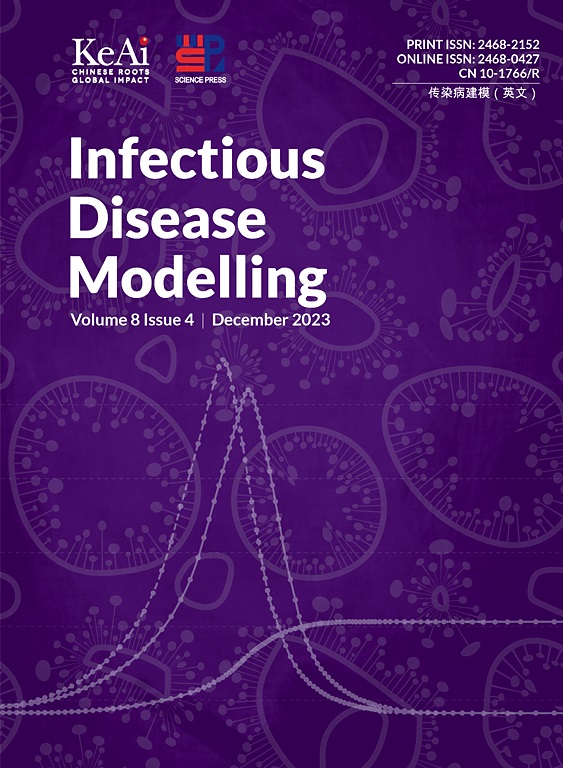Should public health policy exempt cases with low viral load from isolation during an epidemic?: a modelling study
IF 2.5
3区 医学
Q1 Medicine
引用次数: 0
Abstract
As demonstrated during the COVID-19 pandemic, non-pharmaceutical interventions, such as case isolation, are an important element of pandemic response. The overall impact of case isolation on epidemic dynamics depends on a number of factors, including the timing of isolation relative to the onset of contagiousness for each individual instructed to isolate by public health authorities. While there is an extensive literature examining the importance of minimising the delay from exposure to direction to isolate in determining the impact of case isolation policy, less is known about how underlying epidemic dynamics may also contribute to that impact. Empirical observation and modelling studies have shown that, as an epidemic progresses, the distribution of viral loads among cases changes systematically. In principle, this may allow for more targeted and efficient isolation strategies to be implemented. Here, we describe a multi-scale agent-based model developed to investigate how isolation strategies that account for cases viral loads could be incorporated into policy. We compare the impact and efficiency of isolation strategies in which all cases, regardless of their viral load, are required to isolate to strategies in which some cases may be exempt from isolation. Our findings show that, following the epidemic peak, the vast majority of cases identified with a low viral load are in the declining phase of their infection and so contribute less to overall contagiousness. This observation prompts the question about the potential public health value of discontinuing isolation for such individuals. Our numerical investigation of this ‘adaptive’ strategy shows that exempting individuals with low viral loads from isolation following the epidemic peak leads to a modest increase in new infections. Surprisingly, it also leads to a drop in efficiency, as measured by the average number of infections averted per isolated case. Our findings therefore suggest caution in adopting such flexible or adaptive isolation policies. Our multi-scale modelling framework is sufficiently flexible to enable extensive numerical evaluation of more complex isolation strategies that incorporate more disease-specific biological and epidemiological features, supporting the development and evaluation of future public health pandemic response plans.
公共卫生政策是否应该在疫情期间免除病毒载量低的病例隔离?一项模型研究
正如在2019冠状病毒病大流行期间所表明的那样,病例隔离等非药物干预措施是大流行应对的重要组成部分。病例隔离对流行病动态的总体影响取决于许多因素,包括公共卫生当局指示隔离的每个个体相对于传染性发病的隔离时间。虽然有大量文献研究了在确定病例隔离政策的影响时尽量减少从接触到方向隔离的延迟的重要性,但对潜在的流行病动态如何也可能有助于这种影响知之甚少。经验观察和建模研究表明,随着流行病的发展,病例中病毒载量的分布会系统性地发生变化。原则上,这可能允许实现更有针对性和更有效的隔离策略。在这里,我们描述了一个基于多尺度代理的模型,该模型旨在研究如何将考虑病例病毒载量的隔离策略纳入政策。我们比较了隔离策略的影响和效率,在所有情况下,无论其病毒载量如何,都需要隔离的策略,在某些情况下可能免于隔离。我们的研究结果表明,在疫情高峰期之后,绝大多数病毒载量较低的病例处于感染的下降阶段,因此对整体传染性的贡献较小。这一观察结果引发了一个问题,即停止对这些人进行隔离的潜在公共卫生价值。我们对这种“适应性”策略的数值研究表明,在疫情高峰期后免除病毒载量低的个体隔离会导致新感染的适度增加。令人惊讶的是,它还导致效率下降,以每个孤立病例避免感染的平均数量来衡量。因此,我们的研究结果建议在采取这种灵活或适应性隔离政策时要谨慎。我们的多尺度建模框架具有足够的灵活性,能够对包含更多疾病特异性生物学和流行病学特征的更复杂的隔离策略进行广泛的数值评估,支持未来公共卫生大流行应对计划的制定和评估。
本文章由计算机程序翻译,如有差异,请以英文原文为准。
求助全文
约1分钟内获得全文
求助全文
来源期刊

Infectious Disease Modelling
Mathematics-Applied Mathematics
CiteScore
17.00
自引率
3.40%
发文量
73
审稿时长
17 weeks
期刊介绍:
Infectious Disease Modelling is an open access journal that undergoes peer-review. Its main objective is to facilitate research that combines mathematical modelling, retrieval and analysis of infection disease data, and public health decision support. The journal actively encourages original research that improves this interface, as well as review articles that highlight innovative methodologies relevant to data collection, informatics, and policy making in the field of public health.
 求助内容:
求助内容: 应助结果提醒方式:
应助结果提醒方式:


